>
Grandifloras
Dream Come True (AARS 2008). (NR) 35 - 40”. Yellow ruby-red blend that
fades to a light pink. Zone 5, Zone 4 with winter protection. Disease resistant.
About 40 petals. Large, up to 5” blooms.
Strike It Rich (AARS 2007). (NR) 30 - 35” Yellow/orange blend. Good
mix of both single and multiple blooms per stem. Good disease resistance. Sweet spice fragrance. Zone
5, zone 4 with winter protection.
Wild Blue Yonder (AARS
2006). (NR) 25 - 35” Mauve/Lavender. 25 to 30 petals. Ruffled, wavy, velvety blooms. Citrus
and rose scent. Zone 5, zone 4 with winter protection. Stever (NY). Very
weak grower. Nice color; too bad it will not grow up and be a grandiflora. Gibson
(NY) – Grown 2 years. Deep intense color.
About
Face (AARS 2005). (7.6 interim). 30 - 40” Yellow
interior with bronze orange reverse. Clean, medium green foliage. Mostly single
blooms per stem. Fades to a pale yellow. Very attractive. In bloom most of
season. Zone 5, zone 4 with winter protection.
Cherry Parfait (AARS 2005). (7.9) 25 - 30” White edged with red (red blend). Truly
superior quality rose. Effective as a garden, potted and mass planting. Close
to disease free with almost continuous bloom all season. McKeown (NH) – Three years
in my garden. Vigorous grower. Clusters of large blooms are borne on sturdy
stems and puts out a great display. Definitely a keeper. I mound it with mulch
to about 6” each winter.
Miniatures and
Mini-Floras
Baby Boomer (AOE 2003)
(7.7) Miniature. Medium Pink.
Double. Heavy repeat
bloom. Tends to grow more upright
(up to 35 inches) than spreading, with lots of long lasting, exhibition type
single blooms coming all season.
Disease resistant. Zones
5-10. Fragrant.
Bonfire (AOE 2007) (NR).
Miniature. Red Blend. Stever
(NY) – What a disappointment!
Blooms ball and lack form.
Low growing and not very productive. Zones 4-10.
Caliente (AOE 2005) (NR)
Miniature. Dark red. SRS Project Rose for 2006. Not very hardy. We lost both of our plants over the first
winter as did some of the other SRS members in the Syracuse area. Zones
6-10. Stever (NY) - The deep
blooms can have good form; however, plant did suffer from winter dieback and
has been weakened as a result. Be
interesting to see if it improves. Gibson (NY) - Poor performer; does
not adjust to extreme temperatures.
Storms (NY) – Grown one year. Have never had a mini die over the winter; this one
did. White (NY) - Grown one
year; did not survive winter.
Chattooga (AOE 2004). (7.8
interim). Miniature. Deep
pink, double. Nice dark green
foliage and exhibition quality blooms but limited number of blooms. Had
two plants 1st
year – one with nice vigorous canes; the other with just one weak cane. Latter
died over the winter. Zones 5-10. McKeown
(NH) – This is on its third year in my garden, and never without a
bloom. Absolutely love it. Stever
(NY)) – Chattooga is hardy
with a spreading growth habit. Blanchard
(NY) – Borderline hardy. Like
color, grown 3 years. Storms
(NY) – A wonderful, beautiful large exhibition mini. Highly recommend. Grown 2 years. Gibson (NY)
– Multiple
blooms, hold color. White (NY)
- Stingy with blooms that are of exhibition quality. Beautiful foliage.
Doris Morgan (AOE 2003).
(7.7). Miniature. Deep
pink. Large, two inch exhibition
quality blooms. Frequent repeat bloom. Compact bush that is about as wide as tall. Disease
resistant. Zones 5-10. Fragrant.
Harm Saville (AOE 2004)
(7.7 interim). Mini-Flora. Dark Red. Double.
Fragrant. Zones 5-12. McKeown (NH) – I’ve grown this for four
years. I cover it with leaves and
bark mulch. It is a vigorous
grower, but tends to spread out instead of upright. The blooms are an attractive true red. Stever (NY) –
This fast opening, lightly pedaled bush is quite decorative. Now in its third
year it appears to be
losing vigor. Not for exhibition
except as an open bloom.
Leading Lady (AOE 2007)
(NR). Mini-Flora. White Blend. Stever (NY) – Has the best
exhibition form of recent AOE winners.
First year bush grows well and produces nice one bloom per stem
roses. Cohen (NH) – A slow
starter, but the few blooms I had showed great exhibition form.
Picotee (AOE 2003) (7.4
interim). Miniature. Red Blend. Single blooms and sprays. Exhibition quality long lasting blooms but slow to repeat
bloom. Did not survive second
winter. Zones 5-10. McKeown (NH)
– Blooms have good
form, but sparse. Straight and
sturdy stems.
Saluda (AOE 2007) (NR).
Miniature. SRS Project Rose for 2007. Attractive orange with mostly single blooms per stem. Blooms
heavily and repeats well. Very disease and insect resistant. Very vigorous for us in its first year
with new growth up to 25 – 30’ by fall.
Winter hardiness unknown – new this year. Fragrant. Zones 5-10. Stever (NY) – Pleasant shade of soft orange. Lacks
vigor.
Footnotes:
All America Rose
Selections (AARS) Winners.
Designation by a non-profit organization of U.S. producers and
introducers that rate roses as exceptional after meeting their standards as an
exceptional variety after they have been evaluated for two years in test
gardens throughout the U. S. and planted in public display rose gardens a year
before they become available to the general public.
American Rose Society
Award of Excellence (AOE) Winners.
These are miniature and mini-flora roses that were rated over a two-year
period by ARS members of the American Rose Society miniature garden sites
throughout the U.S.
Others contributing to
this article: NH - McKeown, Wilton, NH, Cohen, Dublin, NH; NY – Storms,
Syracuse, NY (Syracuse Suburban), Stever, Liverpool, NY (Most of his comments
are from 2007 Horizon Roses Northeast Report), NY, Gibson, Manlius, NY,
Blanchard, Syracuse, NY (Syracuse Suburban), White (Syracuse Metro).
NR. No Rating yet in
ARS Handbook for
Selecting Roses..
